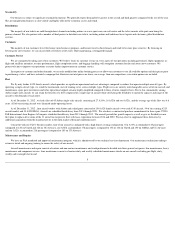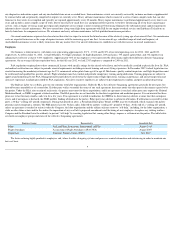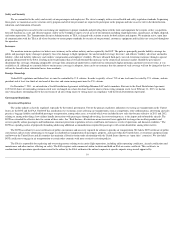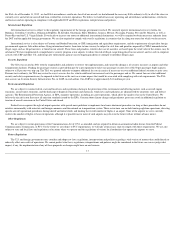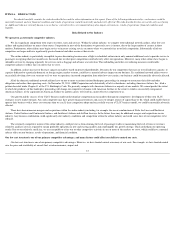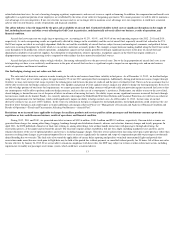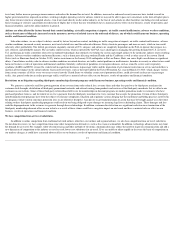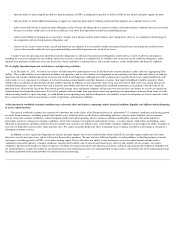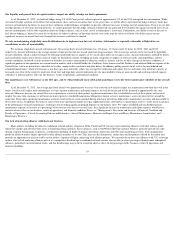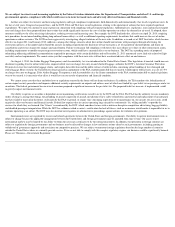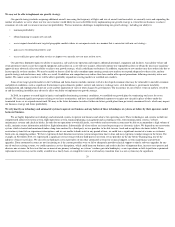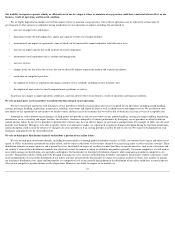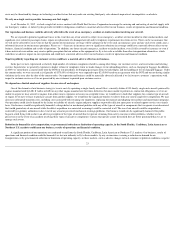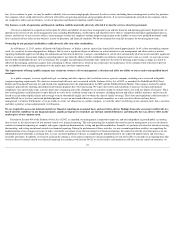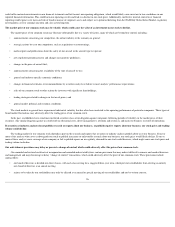Spirit Airlines 2012 Annual Report Download - page 19
Download and view the complete annual report
Please find page 19 of the 2012 Spirit Airlines annual report below. You can navigate through the pages in the report by either clicking on the pages listed below, or by using the keyword search tool below to find specific information within the annual report.
Our liquidity and general level of capital resources impact our ability to hedge our fuel requirements.
As of December 31, 2012 , we had fuel hedges using U.S. Gulf Coast jet fuel collars in place for approximately 5% of our 2013 anticipated fuel consumption. While
we intend to hedge a portion of our future fuel requirements, there can be no assurance that, at any given time, we will be able to enter into fuel hedge contracts. In the past,
we have not had and in the future we may not have sufficient creditworthiness or liquidity to post the collateral necessary to hedge our fuel requirements. Even if we are able
to hedge portions of our future fuel requirements, we cannot guarantee that our hedge contracts will provide any particular level of protection against increased fuel costs or
that our counterparties will be able to perform under our hedge contracts, such as in the case of a counterparty’s insolvency. Furthermore, our ability to react to the cost of
fuel, absent hedging, is limited, because we set the price of tickets in advance of knowing our fuel costs at the time the tickets are flown. Our ability to pass on any
significant increases in aircraft fuel costs through fare increases could also be limited.
We rely on maintaining a high daily aircraft utilization rate to implement our low cost structure, which makes us especially vulnerable to flight delays or
cancellations or aircraft unavailability.
We maintain a high daily aircraft utilization rate. Our average daily aircraft utilization was 12.8 hours, 12.7 hours and 12.8 hours for 2012 , 2011 and 2010 ,
respectively. Aircraft utilization is the average amount of time per day that our aircraft spend carrying passengers. Our revenue per aircraft can be increased by high daily
aircraft utilization, which is achieved in part by reducing turnaround times at airports, so we can fly more hours on average in a day. Aircraft utilization is reduced by delays
and cancellations from various factors, many of which are beyond our control, including air traffic congestion at airports or other air traffic control problems, adverse
weather conditions, increased security measures or breaches in security, international or domestic conflicts, terrorist activity, or other changes in business conditions. A
significant portion of our operations are concentrated in markets such as South Florida, the Caribbean, Latin America and the Northeast and northern Midwest regions of the
United States, which are particularly vulnerable to weather, airport traffic constraints and other delays. In addition, pulling aircraft out of service for unscheduled and
scheduled maintenance, which will increase as our fleet ages, may materially reduce our average fleet utilization and require that we seek short-term substitute capacity at
increased costs. Due to the relatively small size of our fleet and high daily aircraft utilization rate, the unavailability of one or more aircraft and resulting reduced capacity
could have a material adverse effect on our business, results of operations, and financial condition.
Our maintenance costs will increase as our fleet ages, and we will periodically incur substantial maintenance costs due to the maintenance schedules of our aircraft
fleet.
As of December 31, 2012 , the average age of our aircraft was approximately 4.6 years. Our relatively new aircraft require less maintenance now than they will in the
future. Our fleet will require more maintenance as it ages and our maintenance and repair expenses for each of our aircraft will be incurred at approximately the same
intervals. Moreover, because our current fleet was acquired over a relatively short period, significant maintenance that is scheduled on each of these planes will occur at
roughly the same time, meaning we will incur our most expensive scheduled maintenance obligations, known as heavy maintenance, across our present fleet around the
same time. These more significant maintenance activities result in out-of-service periods during which our aircraft are dedicated to maintenance activities and unavailable to
fly revenue service. In addition, the terms of some of our lease agreements require us to pay supplemental rent, also known as maintenance reserves, to the lessor in advance
of the performance of major maintenance, resulting in our recording significant prepaid deposits on our balance sheet. We expect scheduled and unscheduled aircraft
maintenance expenses to increase as a percentage of our revenue over the next several years. Any significant increase in maintenance and repair expenses would have a
material adverse effect on our business, results of operations, and financial condition. Please see “Management’s Discussion and Analysis of Financial Condition and
Results of Operations—Critical Accounting Policies and Estimates—Aircraft Maintenance, Materials and Repair Costs and Heavy Maintenance Amortization” and “—
Maintenance Reserves.”
Our lack of marketing alliances could harm our business.
Many airlines, including the domestic traditional network airlines (American, Delta, United and US Airways) have marketing alliances with other airlines, under
which they market and advertise their status as marketing alliance partners. These alliances, such as OneWorld, SkyTeam and Star Alliance, generally provide for code-
sharing, frequent flier program reciprocity, coordinated scheduling of flights to permit convenient connections and other joint marketing activities. Such arrangements
permit an airline to market flights operated by other alliance members as its own. This increases the destinations, connections and frequencies offered by the airline and
provides an opportunity to increase traffic on that airline’s segment of flights connecting with alliance partners. We currently do not have any alliances with U.S. or foreign
airlines. Our lack of marketing alliances puts us at a competitive disadvantage to traditional network carriers who are able to attract passengers through more widespread
alliances, particularly on international routes, and that disadvantage may result in a material adverse effect on our passenger traffic, business, results of operations and
financial condition.
18


